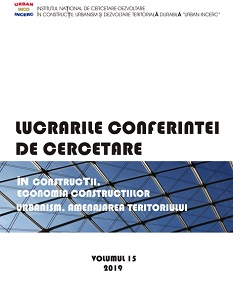Determinarea gradelor de acoperire ale instalaţiilor solare pentru litoralul românesc
Determining the coverage levels of solar installations for the Romanian seaside
Author(s): Horaţiu Gabriel DRAGNE
Subject(s): Architecture
Published by: INCD URBAN-INCERC
Keywords: solar panels; efficiency; costs; seaside; coverage levels
Summary/Abstract: Energy forms the basis for the economic development of any country and plays a significant role in improving the quality of life of the people living there. The importance of energy is apparent in almost every aspect of development and historical data reveals that there is a significant relation between the availability of energy and the economic activity. Though fossil fuel had played a significant and reliable role in this regard but its relentless use over a period of time had created serious problems of climate change. The use of renewable energy especially solar energy in power generation as well as in domestic and building application has gained significant appreciation worldwide to meet the goals of sustainable development and environment conservation. The EU politics support developing this area and introduce mandatory levels of renewable energy productions that raise every 10 years. As an EU member, Romania has the obligation to respect those and invest in developing this area. The Romanian seaside climate is the most appropriate for using the solar panels at full potential in our country. This paper shows the possibility and the limits of adapting a solar thermal energy supply for the energy requirement of a consumer. The simulation done in this study uses the monthly method to estimate the total coverage levels of solar installations. In order to do the simulation, a consumer with a H=16000 W/K for heating and a H=689 W/K for the hot water supply where used. This correspond to the need of energy of 80 apartments for the heating and hot water supply. The monthly intakes of solar energy where calculated and they showed how much renewable energy this kind of system could produce. The monthly coverage levels as well as monthly efficiency are shown in this article in order to fully express the solar usage for the specific consumer. This study used a kc=3 for thermal solar panels and the fallowing characteristics for it: F’ = 0.9; α = 0.9; τ = 0.85; GC = 50 l/m2h; v = V/SC = 50 l/m2. For the heat exchange the fallowing where used: SS = 0,1∙SC and kS = 600 W/m2K. In order to fully maximize the solar energy gains a case with the value for H/kc∙Sc=1 was completed for the hot water supply, as well as a case with a value H/kc∙Sc=5 for heating. The results show that solar panels have good efficiency in this area because of specific climate with warm and sunny days. The year efficiency of the system is much lower than the real efficiency of this setup because of the fact there are periods when the total power produced is much higher than the need of heating or hot water supply. In other words, for the sunny days with high temperature the system produces thermal energy that the consumer cannot use, thus decreasing the efficiency. The difference between the different locations chosen is relatively small, which determine that the values obtained in this study to be universal for the whole seaside area. The results encourage using a solar thermal system on the seaside area. Because of the seasonal occupation and increase of population during the Summer, the seaside area of Romania proves to be the most convenient zone where solar panels should be used to produce thermal energy. And the fact that most buildings are not occupied during winter times offers the opportunity so that this system can be designed in order to achieve just the demand of hot water supply during the Summer. This will lower the cost and surfaces of the needed solar surface which is making the system adaptable for every kind of application.
- Page Range: 191-196
- Page Count: 6
- Publication Year: 2019
- Language: Romanian
- Content File-PDF

